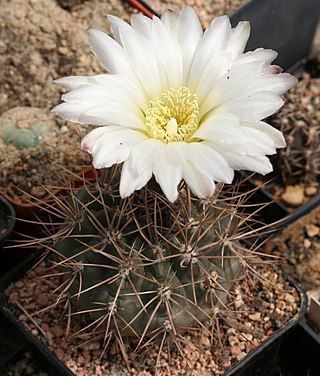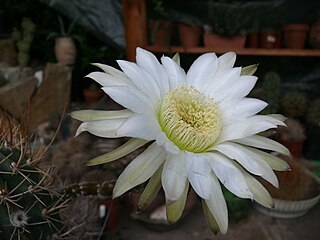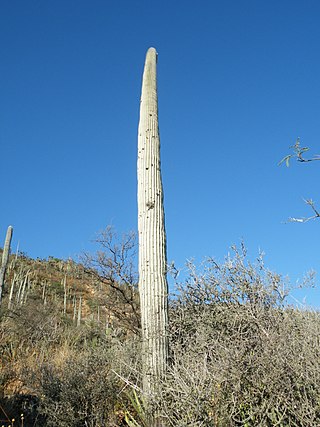
Kadenicarpus horripilus is a species of plant in the family Cactaceae.

Soehrensia schickendantzii is a cactus found in northwestern Argentina in provinces of Salta and Tucumán at elevations of 1600 to 3200 meters.

Lophocereus schottii, the senita cactus, is a species of cactus from southern Arizona and north-western Mexico, particularly Baja California and Sonora.

Leucostele terscheckii, commonly known as the cardon grande cactus or Argentine saguaro, is a large cactus native to South America and popular in cultivation.

Echinocereus pentalophus, with the common name ladyfinger cactus, is a species of Echinocereus cactus, in the tribe Echinocereeae Tribe. It is native to North America.
Frailea gracillima is a species of Frailea from Brazil, Paraguay, and Uruguay.

Cereus aethiops is a species of cactus found from Uruguay to Argentina.

Pelecyphora macromeris, the nipple beehive cactus, is a species of cactus in the United States and Mexico. In the Chihuhuan Desert, it is common and has a wide range.

Stenocereus stellatus is a flowering plant in the family Cactaceae that is found in Oaxaca, Mexico

Gymnocalycium gibbosum is a species of Gymnocalycium from Argentina.

Soehrensia formosa, is a species of Echinopsis found in South America. In north-western Argentina, Bolivia and northern Chile. First published in Cactac.: Handb. Kakteenk. 3: 1678 in 1959.

Corryocactus erectus or is a species of columnar cactus found in Peru.

Pelecyphora tuberculosa, the corncob cactus, is a species of flowering plant in the family Cactaceae, native to the south-central United States, and northern Mexico.

Cleistocactus baumannii is a species of Cleistocactus found in Argentina, Paraguay, Bolivia, Uruguay, and Brazil.

Cereus fernambucensis is a species of Cereus found in Brazil.

Acanthocalycium leucanthum is a species of flowering plant in the cactus family Cactaceae from Argentina.

Cephalocereus columna-trajani is a species of cactus from Mexico.

Pelecyphora dasyacantha is a species of flowering plant in the family Cactaceae, native to the Mexico.

Echinocereus cinerascens is a species of cactus native from Texas to Mexico.
Pelecyphora zilziana is a species of flowering plant in the family Cactaceae, native to Mexico.























